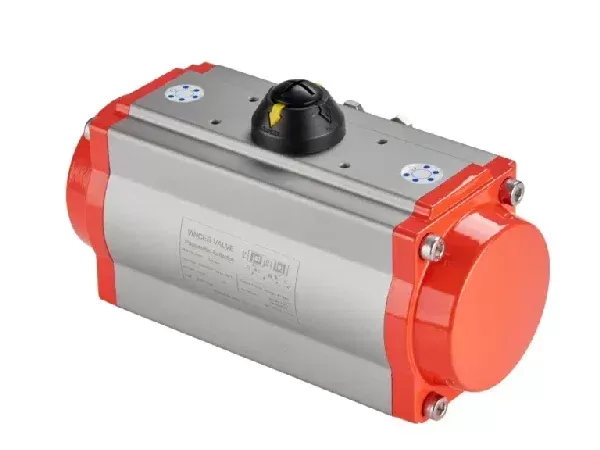Notifications

8 minutes, 40 seconds
-42 Views 0 Comments 0 Likes 0 Reviews

Introduction
We are a leading control valve manufacturer in China, delivering high-quality valves and precision control actuators designed to meet a wide range of industrial applications.
In the realm of automation and mechanical engineering, actuators are essential components that convert energy into mechanical motion. Among the many types of actuators available, pneumatic and electric actuators are two of the most commonly used. Each offers distinct advantages and disadvantages, making them suited for different applications. This article explores the workings of pneumatic and electric actuators, highlights their key differences, and provides guidance on choosing the right actuator for your project.
A pneumatic actuator is a device that converts compressed air (or another gas) into mechanical motion. These actuators are commonly referred to as pneumatic cylinders, air cylinders, or air actuators. Despite the different names, they all operate on the same basic principle.
Pneumatic actuators consist of a piston, cylinder, and control valves. Depending on the type of actuator, they can produce either linear or rotary motion, making them adaptable for various applications.
Pneumatic actuators operate by using pressurized air that enters a chamber. When the pressure inside the chamber exceeds the atmospheric pressure outside, it drives the piston to move, creating a controlled kinetic movement. This movement can either be linear (back-and-forth motion) or rotary (circular motion).
The simplicity of pneumatic actuators lies in their use of compressed air, which is readily available in many industrial settings. Their minimal electrical components make them easy to maintain and repair. However, their efficiency can be impacted by factors like air quality, pressure fluctuations, and the need for a continuous supply of compressed air.
An electric actuator is a device that uses an electric motor to convert electrical energy into mechanical motion. These actuators are known for their precision, control, and ability to handle complex motion profiles, making them ideal for applications requiring high accuracy.
Electric actuators function by converting the rotary motion of an electric motor into linear motion. The motor's spindle is coupled to a helical screw via a drive shaft. As the spindle rotates, it turns the screw within a ball screw nut, causing the nut to move along the screw.
The hollow piston rod attached to the nut creates linear motion as the motor turns in either direction. The motor's rotation speed is controlled by an electric drive, which allows for precise adjustment of the actuator's linear speed. Feedback mechanisms provide positional information, enabling the actuator to stop or return to specific positions as required.
Electric actuators offer a high degree of versatility and can be used in a wide range of applications—from basic positioning tasks to intricate motion control systems.
Pneumatic actuators: Rely on compressed air, making them suitable for environments with a readily available supply of air.
Electric actuators: Use electrical energy, which may be more accessible in environments where electrical power is already in use.
Electric actuators: Offer superior control and precision. They can be programmed to follow complex motion profiles, providing accurate positional feedback.
Pneumatic actuators: While fast and effective, pneumatic actuators typically offer less precise control compared to electric actuators.
Pneumatic actuators: Are typically faster and can generate higher forces in a compact form factor, making them ideal for high-speed, high-force applications.
Electric actuators: Can achieve similar force and speed but may require more powerful motors and specific configurations.
Pneumatic actuators: Require less maintenance due to fewer moving parts and minimal exposure to electrical components.
Electric actuators: While more complex and requiring occasional maintenance, they tend to have a longer lifespan due to their precise control mechanisms.
Pneumatic actuators: Generally have lower upfront costs and are more affordable in environments where compressed air is readily available.
Electric actuators: Often have higher initial costs but can be more cost-effective over time due to their energy efficiency and reduced maintenance needs.
Electric actuators: Tend to be more environmentally friendly because they do not rely on compressed air and can be powered by renewable energy sources.
Pneumatic actuators: Can have a higher environmental impact due to the energy-intensive process required to produce compressed air.
Selecting the right actuator depends on several key factors related to your project's specific needs. Consider the following:
What type of motion is required—linear or rotary? Do you need high precision or complex motion profiles? Pneumatic actuators are best for high-speed, high-force tasks, while electric actuators excel in applications requiring precision and complex motion.
Consider factors such as temperature, humidity, and exposure to dust or chemicals. Pneumatic actuators are more robust in harsh environments, while electric actuators may require additional protection against environmental conditions.
Electric actuators are generally more energy-efficient, especially in applications with frequent starts and stops. Pneumatic actuators, while efficient, can be less energy-efficient due to the continuous supply of compressed air.
Pneumatic actuators are known for their durability and minimal maintenance. Electric actuators, while requiring more complex systems, offer longer lifespans with reduced wear and tear.
Pneumatic actuators tend to be more cost-effective initially, especially in environments with an established compressed air supply. Electric actuators, though more expensive upfront, can prove more economical over time due to lower operating costs.
If your project requires complex control systems or integration with automation systems, electric actuators are ideal due to their flexibility and advanced control options.
Both pneumatic and electric actuators offer unique advantages and drawbacks. Pneumatic actuators excel in speed, force, and durability, making them ideal for high-speed, high-force applications in challenging environments. Electric actuators, however, provide greater precision, control, and energy efficiency, making them perfect for complex and precise applications.
When selecting the best actuator for your project, consider the specific requirements, environmental conditions, energy efficiency, maintenance needs, and budget. By weighing these factors carefully, you can choose the actuator that best fits your needs, ensuring optimal performance and longevity.Know more about Google SEO Directory

